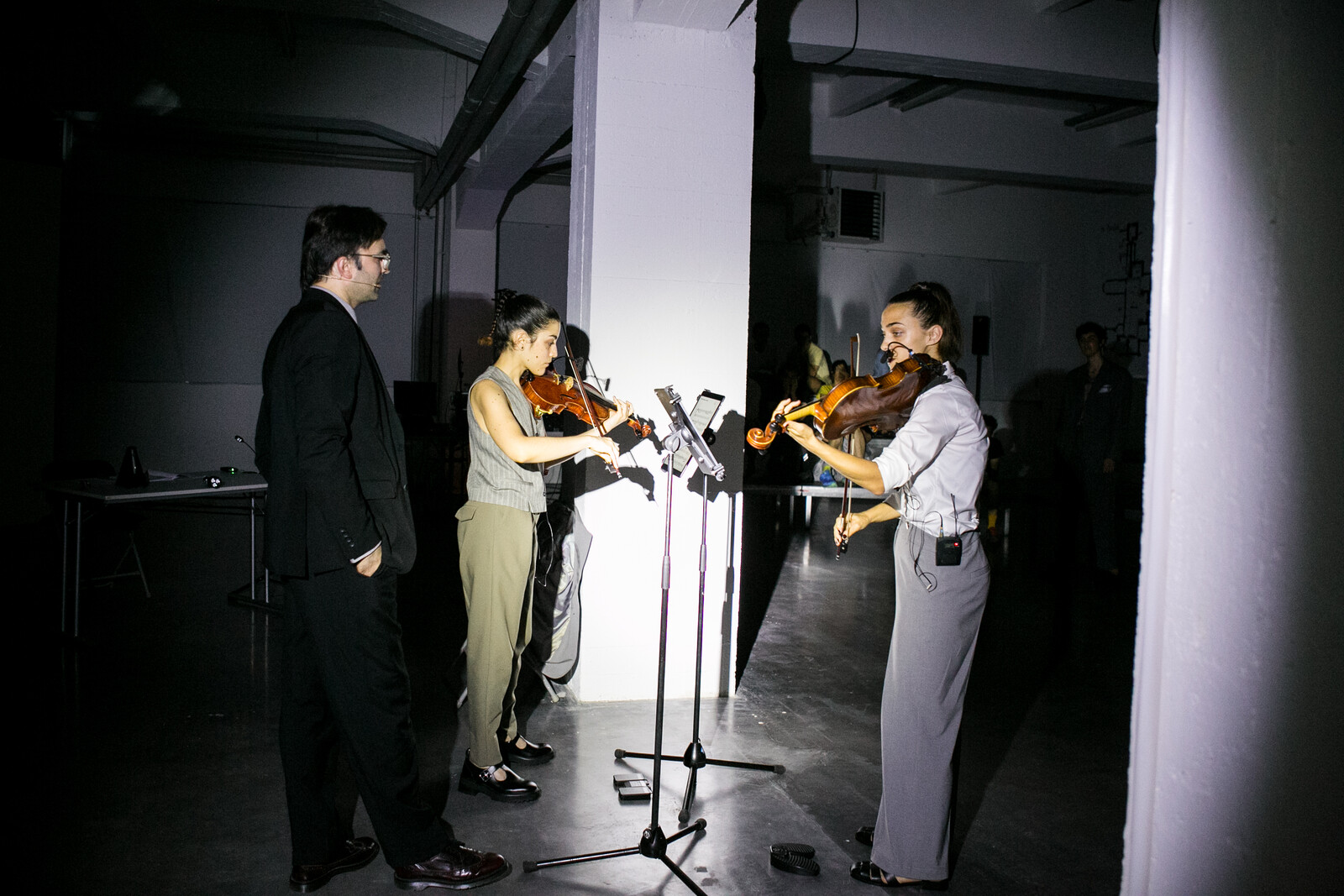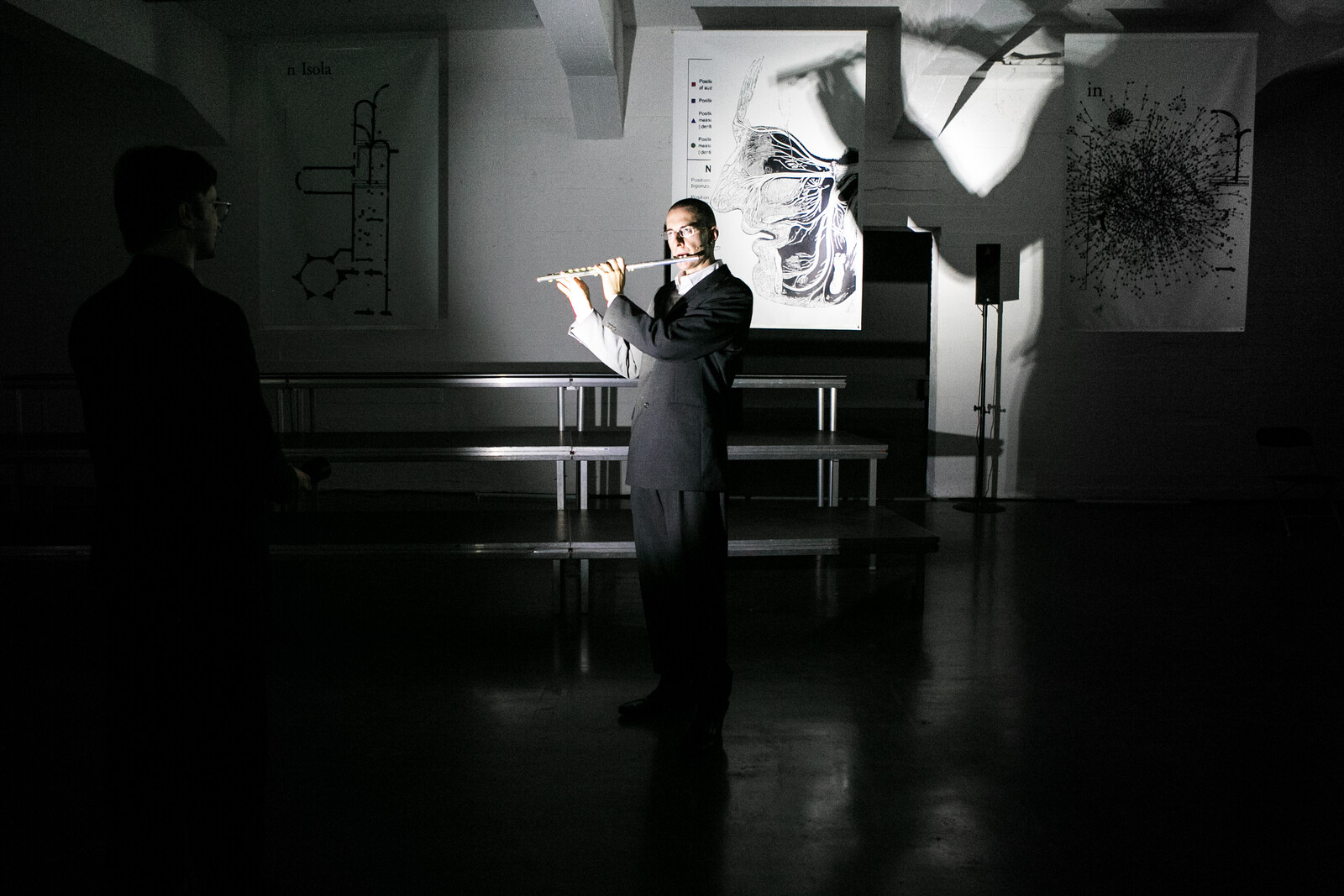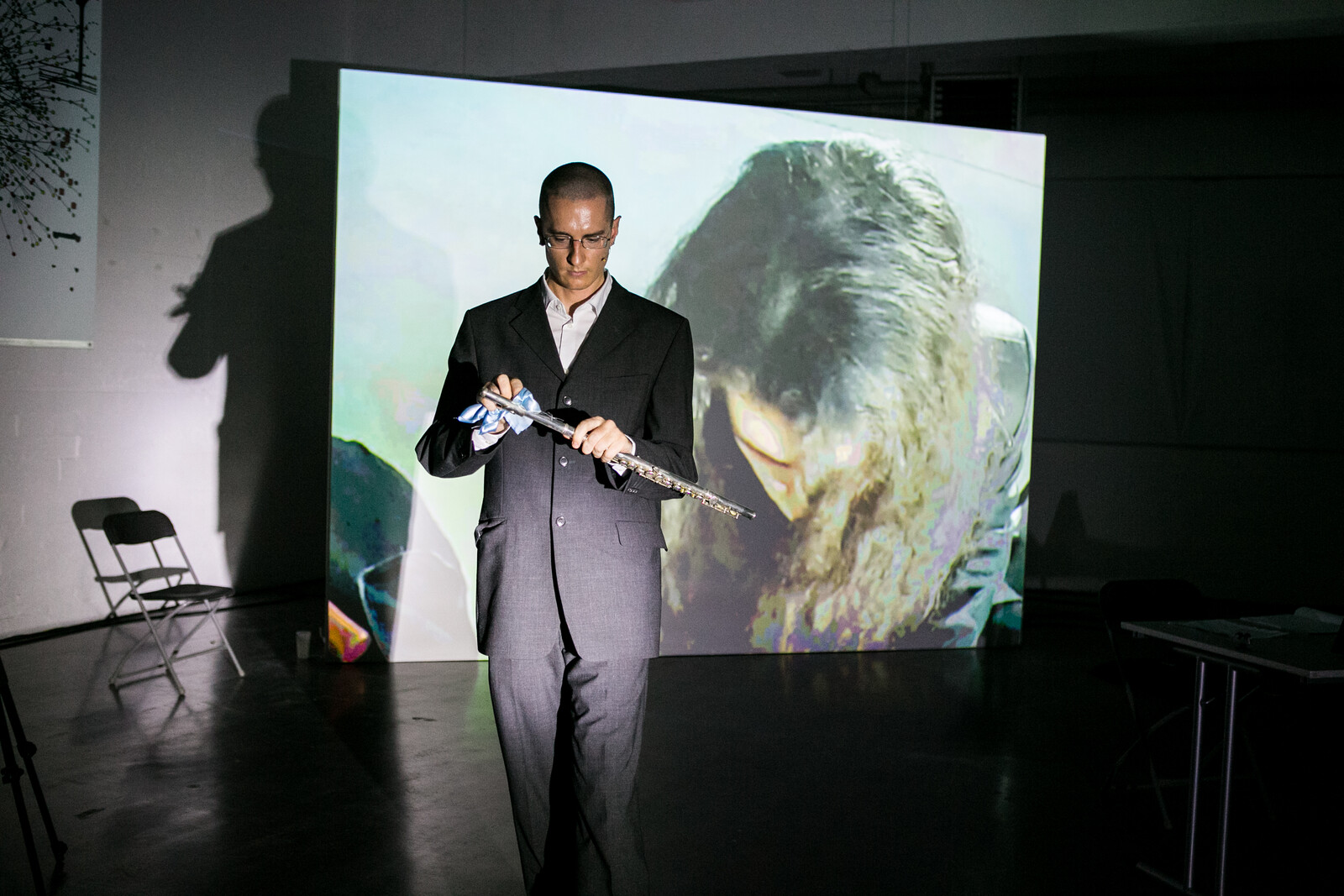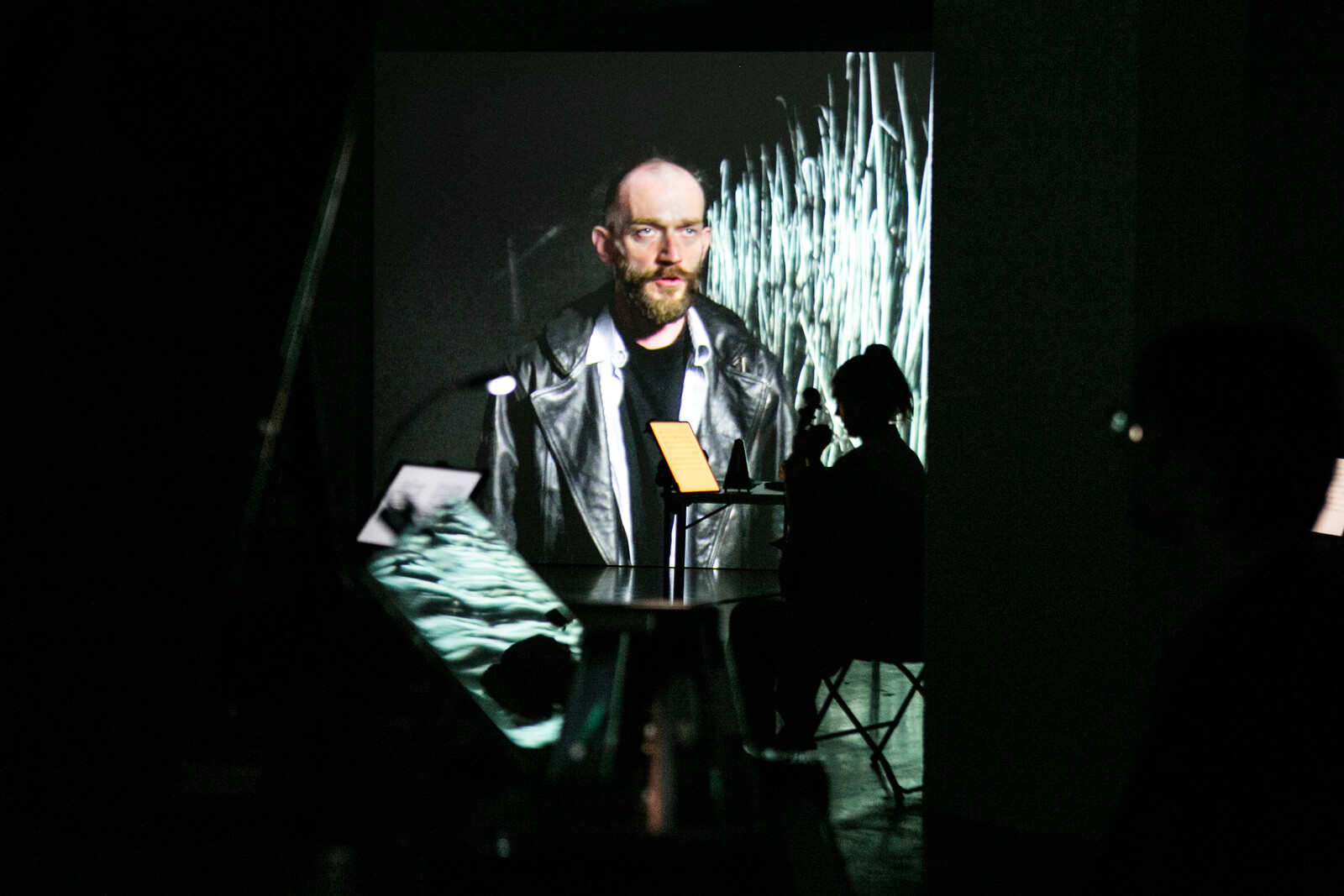“Workers in Song” inverts the current artworld logic of exhibitions augmented by performance programs, and instead positions the live event as the centerpiece and the exhibition its supplement (some of the performance elements, along with a soundtrack, remain on show at WIELS until October 8.) Borrowing their title from a Leonard Cohen song, Belgian composer Billy Bultheel and Welsh artist James Richards staged a collaboration that examines the elasticity of such live events, questioning the relations of appropriated artifacts (poems, films, artworks) to newly constructed material (collaborative videos, sound, banners), of spoken word to music or imagery, and of live performance to pre-recording, thus the very nature of liveness itself.
It takes place in an exhibition room sparsely adorned with banners, rudimentary props (folding chairs, desk, piano), and two large screens hanging opposite each other. Four angled bleachers sit the audience “in-the-round.” A reperformance of Ian White’s Ibiza (2010) is the first of a nine-part program that is dense, heady, jarring, tender, anxiety-inducing, and shot through with moments of beauty and pathos. Liveness was central to the late artist and curator White’s thinking: he saw the rehearsed gesture and performer’s presence as a “false promise” of the live, finding liveness rather in broader contingencies within the room itself, not least the “corporeality of the spectator.”1 Ibiza puts this corporeality under pressure by setting up two channels of content that do not so much complement as obliterate each other. It begins with a man in a suit, sitting at the desk in the darkened room, reading aloud a confessional letter about a failed sex date holiday. Soon Tony Conrad’s 1966 film The Flicker starts up (or rather a digital version of the 16mm original, lovingly remade frame by frame). Projected on the two screens, its strobe effect mounts an optical assault on the audience members. As the reading continues, eventually segueing into an annihilating list of preferences culled from gay dating apps, and a recitation of Yvonne Rainer’s No Manifesto (1965), speech and image do not cohere but remain obstinately separate, enacting a simultaneity that refuses to assimilate.
Ibiza is no gentle preamble but rather a drawn-out feat of endurance, particularly in the unseasonable heat that warmed the room to sauna-like temperatures. Finally over, a flashlight began to stroke the dark space, illuminating its contours and dazzling audience members, until a single note sliced through with piercing clarity: the Ibiza letter-reader turns out to be a flautist. The flute is accompanied by a mournful string trio whose sound swells and seeps into the room, until a video begins and we are elsewhere: in a night-time nature scene, illuminated by another flashlight which cuts a path through tall grass. A man appears, singing the plaintive arias of Franz Schubert’s last song of Winterreise (1828), written when he was dying as a setting to lyrics by a young poet, Wilhelm Müller, who was also soon to die. Mortality hangs in the air like clammy fog as the string musicians strike up, adding another acoustic layer. The man is walking as he sings, but the outdoor scene behind him doesn’t sync up. It is a green-screen simulation and once again, two things appear to be happening at once that refuse to merge entirely.
The event is permeated with these kinds of dislocation, of seams that don’t quite fit together and peel open to ask productive questions about the format of this work. Is it a screening program infiltrated by live performers? Or a recital with filmic interludes? A variety show? A multi-media playlist? Or perhaps, in fact, an exhibition whose dramaturgy has been extracted from the usual sequence of rooms and funneled instead into a single space and made to unfold in time before a static, seated audience?
Richards’s works are indebted to White’s thinking (they met in 2007 on the LUX Associate Artists Program, which White ran), but Bultheel’s has its roots in spectacle, as honed in Anne Imhof’s performances, for which he composed music and performed to memorable effect. In Imhof’s works, the choreographed realness of the cast is pitched against a viewing public, co-opted as material. In “Workers in Song,” the musicians are the cast (all styled with care in baggy suits) and Bultheel’s score takes up the space between them and the audience, swirling around the artefacts, and sometimes twisting into them (a metronome measures time throughout the reading of Rae Armantrout’s extraordinary 2004 poem “Phrasing”).
There are moments that tip into sentimentality (how to respond when, in close-up, tears trickle down the Schubert singer’s face?) But the register quickly shifts again—this is a crammed program—and soon we are watching Amphetamine, an intensely moving black and white film by Warren Sonbert and Wendy Appel from 1966. At a bedsit party, young English lads in neat V-necks are rolling up their shirt sleeves to inject amphetamines in protracted real-time shots, to the relentlessly upbeat refrains of singles by The Supremes. The film culminates in a tender kiss between two male protagonists, the camera circling them in an homage to Hitchcock’s Vertigo (1958). References and cover-versions accumulate, while loss and tragedy form a constant anxious undertone. (Sonbert died of complications from AIDS in 1995.) Further intervals of spare strings and voice surge in the darkened room until another dramatic video begins: this time a long-haired drummer, shot from above in a brutalist tower, performing with steady intensity and matched by live violins. The finale is a filmed tour-de-force in which the flautist, who is here in the room, appears on-screen too, playing while waist deep in water. A doubling that somehow fails to be uncanny: the newly made, so shiny and hard-edged, is often hard to integrate.
The frequent swings of register are dizzying at times, as Richards’s and Bultheel’s distinct sensibilities resist intersection. But the purpose of this collaboration seems not to be a seamless merging but rather for each to lean out into unfamiliar areas; to take risks with format, content, or production within the protected zone of a partnership. A delicate emotive space is constructed that alludes to the intertwining of pleasure and mortality, touching on beauty and sorrow, while asking how to be free: through drugs or sex? Music or expression? Resistance or acceptance?
The piece converges in a final musical crystallization: a gorgeous piano and voice rendition after Robert Wyatt’s version of Nile Rodgers and Chic’s At Last I am Free from 1978– another cover of a cover. Its ambivalent refrain—“at last I am free, I can hardly see in front of me”—suggests abandonment to the present moment to be a condition of freedom. The audience here is immersed in just such an unstable, expansive present. In White’s words, this “place of questions [is] a site where things can happen, shifts might occur. It doesn’t always occur, but that’s the beauty of the effort that is shared and made with an audience.”2 And indeed, while the slippages and overlapping of live music and recorded soundtrack, or in-person speech versus the disembodied voice, examine the nature of various rehearsed gestures, it is in the physical presence of all these bodies—sitting together on bleachers, immersed, stunned and fanning themselves in the heat—that this work’s liveness may be found and measured.
Ian White, “Performer, Audience, Mirror: Cinema, Theatre and the Idea of the Live,” in Here is Information. Mobilise (London: LUX, 2016), 258.
Ian White, “Romantic, Beyond, Impossible and Heartbreaking: An open response to Tilda Swinton’s 2002 Vertigo address ‘In the Spirit of Derek Jarman’,” in This is Information. Mobilise (London: Lux, 2016), 38.




